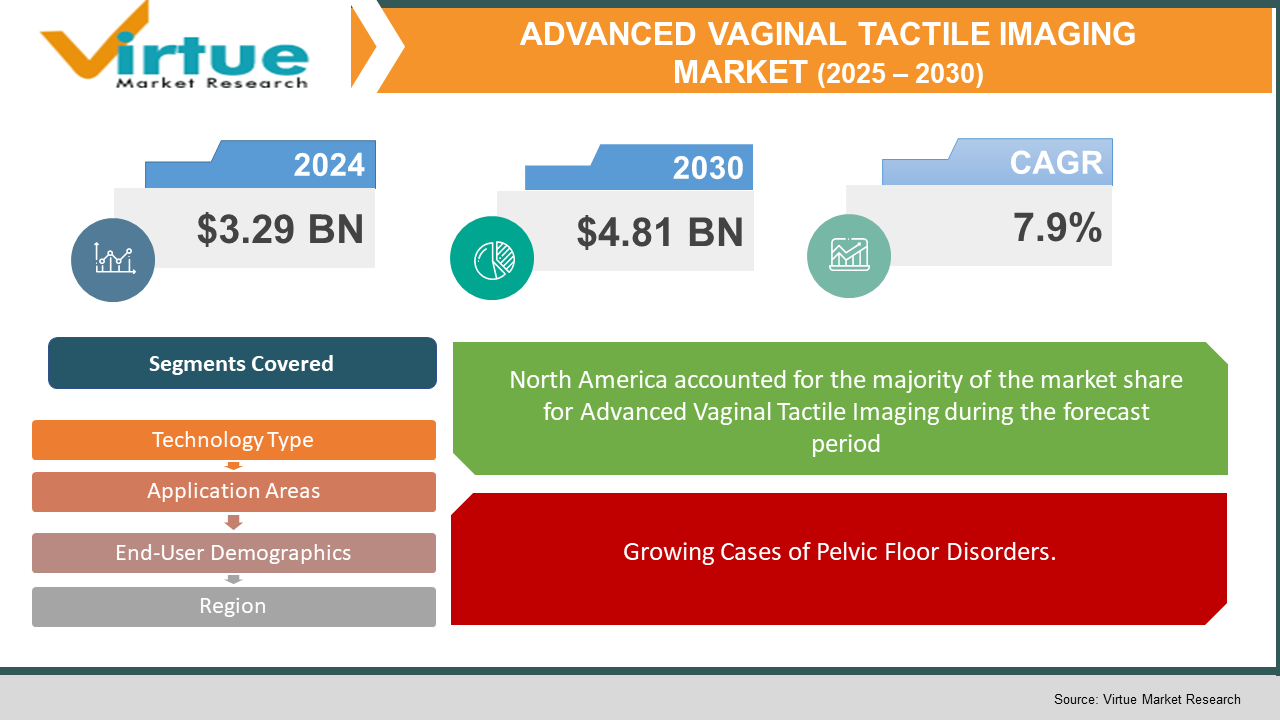Advanced Vaginal Tactile Imaging Market Size (2025-2030)
The Advanced Vaginal Tactile Imaging Market was valued at $3.29 billion in 2024 and is projected to reach a market size of $4.81 billion by the end of 2030. Over the forecast period of 2025-2030, the market is projected to grow at a CAGR of 7.9%.

The Advanced Vaginal Tactile Imaging (VTI) market is changing quickly with new tech that's making women’s healthcare better. These VTI devices mix touch sensors with imaging tools like ultrasound to give a detailed view of vaginal tissues. They're really helpful for understanding issues with pelvic floor disorders, evaluating surgery results, and checking on obstetric care.
These devices are user-friendly, letting doctors easily collect and analyze data, often through smartphones or cloud services. This fits into the broader trend of digital changes in healthcare.
Overall, the VTI market is becoming a crucial part of modernizing women’s health diagnostics, driven by tech advancements and a drive to enhance clinical results.
Key Market Insights:
- Advanced Vaginal Tactile Imaging devices that combine both tactile and ultrasound tech make up about 65% of the market. This is mainly because they offer better diagnostic accuracy and pelvic floor assessments than just tactile images on their own.
- Devices that provide real-time biomechanical mapping and use AI analysis account for around 60% of the market. More healthcare providers are turning to smart imaging solutions to improve diagnosis and create personalized treatment plans for pelvic floor disorders.
- The rate at which cloud-connected VTI devices are being adopted is climbing at about 18% each year. This growth is driven by trends in remote patient monitoring and the ease of integrating with electronic health records, making data more accessible and supporting telehealth options.
- Awareness campaigns about pelvic floor health and the rising demand for non-invasive, objective diagnostic tools are leading to a steady increase in VTI usage. About 40% of new users are coming from sectors focused on women’s wellness and reconstructive surgeries.
Advanced Vaginal Tactile Imaging Market Key Drivers:
AI and Imaging in Pelvic Floor Diagnostics is Driving the Market.
Combining AI and advanced imaging tools is changing the game for pelvic floor diagnostics. These technologies let doctors analyze data on the go, which makes it easier to spot issues like pelvic organ prolapse and urinary incontinence. The Vaginal Tactile Ultrasound Imager (TIUSv) is a great example, providing better views and assessments of pelvic floor problems.
Growing Cases of Pelvic Floor Disorders.
More women are experiencing pelvic floor disorders like organ prolapse and urinary incontinence these days. This trend is driving the need for non-invasive and accurate diagnostic tools, such as VTI. By mapping out the vaginal tissues in detail, VTI helps healthcare providers catch these problems early and plan treatments, leading to better outcomes for patients.
Focus on Personalized Care for Women.
There’s a bigger emphasis on personalized healthcare in women’s health, which is pushing for diagnostic tools that cater to individual needs. VTI technology plays a key role by offering specific data on tissue elasticity and pelvic floor function, allowing for customized treatment plans. This approach not only boosts patient involvement but also increases satisfaction, making VTI more popular in clinical settings.
Advanced Vaginal Tactile Imaging Market Restraints and Challenges:
Challenges in the Advanced Vaginal Tactile Imaging Market.
The Advanced Vaginal Tactile Imaging (VTI) market has potential, but it's running into some tough challenges that could slow down its growth. One big issue is the high cost of these advanced gynecological devices. Smaller healthcare facilities, particularly in developing areas, might struggle to afford them, which means fewer people can access these important diagnostic tools. Another challenge is that VTI needs a lot of solid clinical evidence to prove that it works well and is useful. There’s a need for thorough studies to back up VTI's effectiveness in diagnosis and treatment, which is key for getting healthcare providers on board. On top of that, there are strict regulations to navigate. To get approval from health authorities, companies have to go through detailed testing and provide lots of documentation. This can delay when VTI devices hit the market. While these regulatory checks are important for keeping patients safe, they can also be time-consuming and take up a lot of resources for manufacturers. All in all, these issues—costs, the need for strong clinical proof, and tough regulations—create real obstacles to bringing VTI technology into more women's healthcare settings.
Advanced Vaginal Tactile Imaging Market Opportunities:
Opportunities in the Advanced Vaginal Tactile Imaging Market.
The Advanced Vaginal Tactile Imaging (VTI) market is set to grow, thanks to new technology and more awareness around women's pelvic health. One big change here is combining VTI with digital health tools. This can allow for remote check-ups and custom treatment plans, making it easier for patients to stay engaged and follow their therapy. Plus, creating portable and easy-to-use VTI devices helps bring care to areas that may lack services for women's health. With more people facing pelvic floor issues and an aging population, there’s a real need for better diagnostic tools like VTI. Using artificial intelligence and machine learning could improve how these systems work and make clinical processes smoother. As healthcare begins to focus more on prevention, VTI’s potential to catch early signs of pelvic problems makes it an important part of regular gynecological check-ups. Also, partnerships between device makers and research organizations are driving new advancements in VTI technology. These improvements can lead to better results for patients and new research opportunities. All in all, new tech, a rising demand for women's health care, and favorable healthcare policies are creating a great environment for the growth of the VTI market.
ADVANCED VAGINAL TACTILE IMAGING MARKET REPORT COVERAGE:
|
REPORT METRIC |
DETAILS |
|
Market Size Available |
2024 - 2030 |
|
Base Year |
2024 |
|
Forecast Period |
2025 - 2030 |
|
CAGR |
6.1% |
|
Segments Covered |
By Technology Type, application areas, end user demographics, and Region |
|
Various Analyses Covered |
Global, Regional & Country Level Analysis, Segment-Level Analysis, DROC, PESTLE Analysis, Porter’s Five Forces Analysis, Competitive Landscape, Analyst Overview on Investment Opportunities |
|
Regional Scope |
North America, Europe, APAC, Latin America, Middle East & Africa |
|
Key Companies Profiled |
Advanced Tactile Imaging, Inc., Artann Laboratories, Hyivy Health, COSM Medical, Juniper Biomedical, Axena Health, SWORD Health, Elvie, Promax, MinXray, Inc. |
Advanced Vaginal Tactile Imaging Market Segmentation:
Advanced Vaginal Tactile Imaging Market Segmentation: By Technology Type
- Vaginal Tactile Imager (VTI)
- Vaginal Tactile Ultrasound Imager (TIUSv)
- Antepartum Tactile Imager (ATI)
The Vaginal Tactile Ultrasound Imager (TIUSv) is the fastest-growing item in the Advanced Vaginal Tactile Imaging market. Launched in 2021, it combines tactile imaging and ultrasound tech, allowing for a better look at the pelvic floor's properties and structures. This mix helps doctors get a clearer picture, especially for issues like pelvic organ prolapse and urinary incontinence. By showing tissue elasticity and muscle function in real-time, TIUSv helps with more accurate diagnoses and custom treatment plans. Its quick rise in popularity comes from offering more details than older methods, making it an asset in gynecology.
On the other hand, the Vaginal Tactile Imager (VTI) is still the top technology out there. As the first FDA-approved device in this field, VTI is well-established for checking pelvic floor disorders. It gives high-resolution maps of vaginal pressures and assesses the strength of pelvic muscles, providing solid data for diagnosis and treatment. Its ease of use and proven results keep it a key player in women's pelvic health management.
Advanced Vaginal Tactile Imaging Market Segmentation: By Application Areas
- Pelvic Floor Disorders
- Reconstructive Surgery Assessment
- Obstetric Applications
- Vaginal Aesthetic Procedures
Pelvic Floor Disorders (PFDs) are the focus of the Advanced Vaginal Tactile Imaging (VTI) market. VTI offers detailed mapping of vaginal tissues, making it great for diagnosing issues like pelvic organ prolapse and urinary incontinence. Since it's non-invasive and provides objective assessments, it’s widely used in clinics to evaluate surgeries and monitor pelvic health. Healthcare professionals prefer it for its accuracy in checking tissue elasticity and support.
On the other hand, Vaginal Aesthetic Procedures are quickly becoming the fastest-growing part of the VTI market. This growth is due to increasing acceptance and demand for cosmetic treatments that improve vaginal appearance and function. VTI is useful for assessing and evaluating these procedures to ensure patients are satisfied. The rise of elective surgeries like labiaplasty and vaginal tightening, along with better minimally invasive techniques, is driving more use of VTI in this area, and it should keep growing in the future.
Advanced Vaginal Tactile Imaging Market Segmentation: By End-User Demographics
- Hospitals & Clinics
- Research Institutions
- Pharmaceutical Companies
- Direct-to-Consumer Platforms
Hospitals and clinics are the main users of Advanced Vaginal Tactile Imaging (VTI). They provide gynecological care with skilled staff and good facilities, which helps them use new diagnostic tools like VTI. Hospitals are key in addressing various gynecological needs thanks to their centralized services, specialized equipment, and strong reimbursement policies.
Direct-to-consumer (DTC) platforms are quickly gaining traction in the VTI market. As digital health solutions grow and awareness of women's health increases, more women are looking for personalized care. DTC platforms make it easy for women to access health info and services, allowing them to take control of their health. Their user-friendly design and tech progress are driving their popularity.
Advanced Vaginal Tactile Imaging Market Segmentation: By Region
- North America
- Europe
- Asia-Pacific
- Latin America
- Middle East and Africa
The global market for Advanced Vaginal Tactile Imaging (VTI) is spread out across different regions. North America leads the way with about 40% of the market in 2024, due to great tech, solid diagnostic methods, and a strong focus on women’s health. Europe comes next with around 30% of the market, pushed by forward-thinking healthcare policies and a rising need for non-invasive gynecological tests. The Asia-Pacific area holds about 20% of the market, driven by fast healthcare growth, more awareness among patients, and increased investment in medical tech. Latin America and the Middle East & Africa each make up about 5%, showing they have the potential for growth as healthcare access improves and more government support for women’s health diagnostics emerges.
COVID-19 Impact Analysis on the Advanced Vaginal Tactile Imaging Market:
The COVID-19 pandemic shook up the Advanced Vaginal Tactile Imaging (VTI) market. Many elective gynecological procedures got pushed back, and hospitals shifted their focus to dealing with the virus, which meant fewer people were using gynecological devices. For example, in Canada, there was a 15.1% drop in hysterectomy procedures in 2020 compared to the year before. This drop was seen all around the world since hospitals were focusing on COVID-19 patients, making it hard for women to get regular health services. On top of that, supply chain issues and regulatory problems made it tough to produce and distribute advanced diagnostic tools like VTI. But the pandemic also showed just how important women's health diagnostics are, leading to more investment in telemedicine and remote monitoring. As healthcare systems adjust to this new normal, there’s a bigger push to incorporate advanced tech to improve patient care and prepare for any future challenges. So, while the VTI market faced some bumps during the pandemic, it should bounce back and grow as the need for women's health diagnostics picks up again.
Trends/Developments:
In October 2024, a top European manufacturer rolled out an eco-friendly VTI system made from sustainable materials. This move comes as more people look for greener medical devices.
In August 2024, health regulators in the Asia-Pacific region sped up approvals for various VTI devices. This helped grow the market in countries like China, Japan, and India, as more folks became aware of pelvic health issues.
In April 2024, a big clinical study showed that using advanced tactile imaging improved treatment results in personalized pelvic floor therapy. This emphasized how valuable this technology can be.
In February 2024, InnovateMed launched a new generation of VTI devices that come with better wireless connectivity and smartphone integration. This allows for easy remote diagnostics and real-time chats between clinicians and patients.
In November 2023, a global healthcare tech company teamed up with several top hospitals to bring cloud-based VTI solutions into play. This enabled telehealth diagnostics and centralized management of patient data.
In September 2023, FemTech startup SensuVibe introduced a direct-to-consumer VTI device for early pelvic health checks. This aims to make health monitoring better and let women keep tabs on their health at home.
In June 2023, the FDA approved a next-gen vaginal tactile imaging platform that uses AI to help interpret data automatically. This can lighten the load for clinicians and help standardize diagnostic results.
In March 2023, a collaboration between a European university and a medical device company announced successful trials for a portable VTI system designed for home use. This showed the potential for patient convenience and monitoring from afar.
In January 2023, MedGyn launched its latest VTI device with improved 3D imaging. This boosts diagnostic accuracy for pelvic floor disorders and helps clinicians create detailed tactile maps.
Key Players:
- Advanced Tactile Imaging, Inc.
- Artann Laboratories
- Hyivy Health
- COSM Medical
- Juniper Biomedical
- Axena Health
- SWORD Health
- Elvie
- Promax
- MinXray, Inc.
Chapter 1. Advanced Vaginal Tactile Imaging Market – SCOPE & METHODOLOGY
1.1. Market Segmentation
1.2. Scope, Assumptions & Limitations
1.3. Research Methodology
1.4. Primary Source
1.5. Secondary Source
Chapter 2. Advanced Vaginal Tactile Imaging Market – EXECUTIVE SUMMARY
2.1. Market Size & Forecast – (2025 – 2030) ($M/$Bn)
2.2. Key Trends & Insights
2.2.1. Demand Side
2.2.2. Supply Side
2.3. Attractive Investment Propositions
2.4. COVID-19 Impact Analysis
Chapter 3. Advanced Vaginal Tactile Imaging Market – COMPETITION SCENARIO
3.1. Market Share Analysis & Company Benchmarking
3.2. Competitive Strategy & Packaging TECHNOLOGY TYPE Scenario
3.3. Competitive Pricing Analysis
3.4. Supplier-Distributor Analysis
Chapter 4. Advanced Vaginal Tactile Imaging Market - ENTRY SCENARIO
4.1. Regulatory Scenario
4.2. Case Studies – Key Start-ups
4.3. Customer Analysis
4.4. PESTLE Analysis
4.5. Porters Five Force Model
4.5.1. Bargaining Power of Suppliers
4.5.2. Bargaining Powers of Customers
4.5.3. Threat of New Entrants
4.5.4. Rivalry among Existing Players
4.5.5. Threat of Substitutes Players
4.5.6. Threat of Substitutes
Chapter 5. Advanced Vaginal Tactile Imaging Market - LANDSCAPE
5.1. Value Chain Analysis – Key Stakeholders Impact Analysis
5.2. Market Drivers
5.3. Market Restraints/Challenges
5.4. Market Opportunities
Chapter 6. Advanced Vaginal Tactile Imaging Market – By TECHNOLOGY TYPE
6.1 Introduction/Key Findings
6.2 Vaginal Tactile Imager (VTI)
6.3 Vaginal Tactile Ultrasound Imager (TIUSv)
6.4 Antepartum Tactile Imager (ATI)
6.5 Y-O-Y Growth trend Analysis By TECHNOLOGY TYPE
6.6 Absolute $ Opportunity Analysis By TECHNOLOGY TYPE , 2025-2030
Chapter 7. Advanced Vaginal Tactile Imaging Market – By Application Areas
7.1 Introduction/Key Findings
7.2 Pelvic Floor Disorders
7.3 Reconstructive Surgery Assessment
7.4 Obstetric Applications
7.5 Vaginal Aesthetic Procedures
7.6 Y-O-Y Growth trend Analysis By Application Areas
7.7 Absolute $ Opportunity Analysis By Application Areas , 2025-2030
Chapter 8. Advanced Vaginal Tactile Imaging Market – By End-User Demographics
8.1 Introduction/Key Findings
8.2 Hospitals & Clinics
8.3 Research Institutions
8.4 Pharmaceutical Companies
8.5 Direct-to-Consumer Platforms
8.6 Y-O-Y Growth trend Analysis End-User Demographics
8.7 Absolute $ Opportunity Analysis End-User Demographics , 2025-2030
Chapter 9. Advanced Vaginal Tactile Imaging Market , BY GEOGRAPHY – MARKET SIZE, FORECAST, TRENDS & INSIGHTS
9.1. North America
9.1.1. By Country
9.1.1.1. U.S.A.
9.1.1.2. Canada
9.1.1.3. Mexico
9.1.2. By Application Areas
9.1.3. By End-User Demographics
9.1.4. By TECHNOLOGY TYPE
9.1.5. Countries & Segments - Market Attractiveness Analysis
9.2. Europe
9.2.1. By Country
9.2.1.1. U.K.
9.2.1.2. Germany
9.2.1.3. France
9.2.1.4. Italy
9.2.1.5. Spain
9.2.1.6. Rest of Europe
9.2.2. By Application Areas
9.2.3. By End-User Demographics
9.2.4. By TECHNOLOGY TYPE
9.2.5. Countries & Segments - Market Attractiveness Analysis
9.3. Asia Pacific
9.3.1. By Country
9.3.1.1. China
9.3.1.2. Japan
9.3.1.3. South Korea
9.3.1.4. India
9.3.1.5. Australia & New Zealand
9.3.1.6. Rest of Asia-Pacific
9.3.2. By Application Areas
9.3.3. By End-User Demographics
9.3.4. By TECHNOLOGY TYPE
9.3.5. Countries & Segments - Market Attractiveness Analysis
9.4. South America
9.4.1. By Country
9.4.1.1. Brazil
9.4.1.2. Argentina
9.4.1.3. Colombia
9.4.1.4. Chile
9.4.1.5. Rest of South America
9.4.2. By End-User Demographics
9.4.3. By Application Areas
9.4.4. By TECHNOLOGY TYPE
9.4.5. Countries & Segments - Market Attractiveness Analysis
9.5. Middle East & Africa
9.5.1. By Country
9.5.1.1. United Arab Emirates (UAE)
9.5.1.2. Saudi Arabia
9.5.1.3. Qatar
9.5.1.4. Israel
9.5.1.5. South Africa
9.5.1.6. Nigeria
9.5.1.7. Kenya
9.5.1.8. Egypt
9.5.1.9. Rest of MEA
9.5.2. By End-User Demographics
9.5.3. By Application Areas
9.5.4. By TECHNOLOGY TYPE
9.5.5. Countries & Segments - Market Attractiveness Analysis
Chapter 10. Advanced Vaginal Tactile Imaging Market – Company Profiles – (Overview, Product Portfolio, Financials, Strategies & Developments)
10.1 Advanced Tactile Imaging, Inc.
10.2 Artann Laboratories
10.3 Hyivy Health
10.4 COSM Medical
10.5 Juniper Biomedical
10.6 Axena Health
10.7 SWORD Health
10.8 Elvie
10.9 Promax
10.10 MinXray, Inc.
Download Sample
Choose License Type
2500
4250
5250
6900
Frequently Asked Questions
The market is driven by rising awareness of pelvic floor disorders, technological advancements in imaging accuracy, and a growing demand for non-invasive diagnostic tools.
Hospitals & clinics, research institutions, and pharmaceutical companies are leading adopters, using these devices for diagnosis, research, and treatment development.
Integration of AI and machine learning enhances data interpretation, enabling more precise diagnostics and personalized treatment plans
North America leads with high healthcare spending, followed by rapid adoption in Europe and emerging markets in Asia-Pacific
Trends include the rise of portable and home-use devices, cloud-connected platforms for telehealth, and increased focus on women’s pelvic health awareness.



